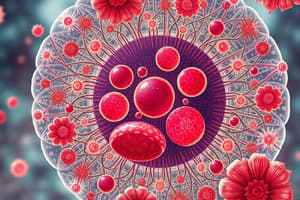Podcast
Questions and Answers
What is the primary function of the mitochondria in a cell?
What is the primary function of the mitochondria in a cell?
- Energy production (correct)
- Genetic material storage
- Waste detoxification
- Protein synthesis
Which organelle is responsible for packaging and distributing proteins within the cell?
Which organelle is responsible for packaging and distributing proteins within the cell?
- Smooth endoplasmic reticulum
- Ribosomes
- Lysosomes
- Golgi apparatus (correct)
In photosynthesis, what is the primary purpose of chlorophyll?
In photosynthesis, what is the primary purpose of chlorophyll?
- To absorb carbon dioxide
- To release oxygen
- To capture light energy (correct)
- To produce glucose
What structure regulates the passage of substances into and out of a cell?
What structure regulates the passage of substances into and out of a cell?
Which of the following diseases is caused by a mutation in the DNA?
Which of the following diseases is caused by a mutation in the DNA?
Flashcards are hidden until you start studying
Study Notes
Course Title: Color Vision (UE 10)
- Course is titled UE 10
- Course is about color vision
- Course instructor is Karen Ponton
Color Definition
- Color is the quality of light reflected from an object.
- It is a visual impression associated with light.
- Physicists define color as a spectral color, related to the wavelength of light perceived by the human eye.
- Color characteristics are defined by three elements: hue, saturation, and value (or brightness).
Color Attributes
- Hue (or tone): The most recognizable characteristic of color. The eye can distinguish about 200 different hues, which correspond to distinct wavelengths.
- Saturation (or chroma): A measure of purity or intensity of a color. High saturation (vivid colors) means a color is strong and pure; low saturation (pale colors) means a color is mixed with white or gray.
- Value (or brightness): Describes how light or dark a color is. High value means light, low value means dark.
Color Classification
- Primary colors: Basic colors that cannot be created by mixing other colors. Usually red, yellow, and blue.
- Secondary colors: Created by mixing two primary colors. Usually orange, green, and violet.
- Tertiary colors: Created by mixing a primary color with a neighboring secondary color.
Color Wheel
- A circular diagram that arranges colors based on their relationships.
- It illustrates relationships between primary, secondary, and tertiary colors.
- Complementary colors sit opposite each other.
- Warm colors are usually warmer and cool colors are usually cooler.
Physical Aspects of Color
-
Light can be separated into different wavelengths by prisms. This was demonstrated by Newton in 1666.
-
Different wavelengths correspond to different colors in spectrum.
-
White light's appearance is composed of all wavelengths, each corresponding to a specific color.
-
A monochromatic light source/beam emits only one wavelength.
-
Transmission: A filtering material that transmits some wavelengths and blocks others.
-
Reflection: An object absorbs all wavelengths of light, including some in the visual spectrum, except for the wavelength or wavelengths that are reflected to the eye.
-
The visible portion of the electromagnetic spectrum is a small part of the spectrum detected by the human eye (380nm to 780nm).
Anatomical Aspects of Color Vision
- Retina: A thin membrane lining the inside of the eye, the Retina perceives images and transmits them to the brain.
- Photoreceptors: Cells in the retina that react to light. There are two types
- Cones: Cone cells are responsible for color vision and best functioning in bright light ('photopic'). There are three types of cones, with varying sensitivities to three primary colors; Long-wavelength (L), medium wavelength (M), and short wavelength (S).
- They are more concentrated in the fovea.
- Rods: Rod cells detect light and dark, crucial for night vision ('scotopic').
- They are more abundant in the periphery of the retina.
Anomalies of Color Vision
- Defects in color vision can be congenital (present at birth) or acquired (develop later in life).
- Congenital color vision defects: Affect the cones' ability to detect wavelength differences.
- Achromatopsia: A complete inability to distinguish colors.
- Dichromatism (typical problem): The inability to perceive one of the three basic colors (red, green, or blue).
- Protanopia: Inability to see red
- Deuteranopia: Inability to see green.
- Tritanopia: Inability to see blue.
- Acquired color vision defects: Result from damage to eye structures or disease.
- Chromatopsia: A perception of a color overload.
- Color central defects: Loss or weakening of color perception
- "Low discrimination": A reduced ability to discriminate colors, commonly resulting in hesitation when making color judgments.
Studying That Suits You
Use AI to generate personalized quizzes and flashcards to suit your learning preferences.




